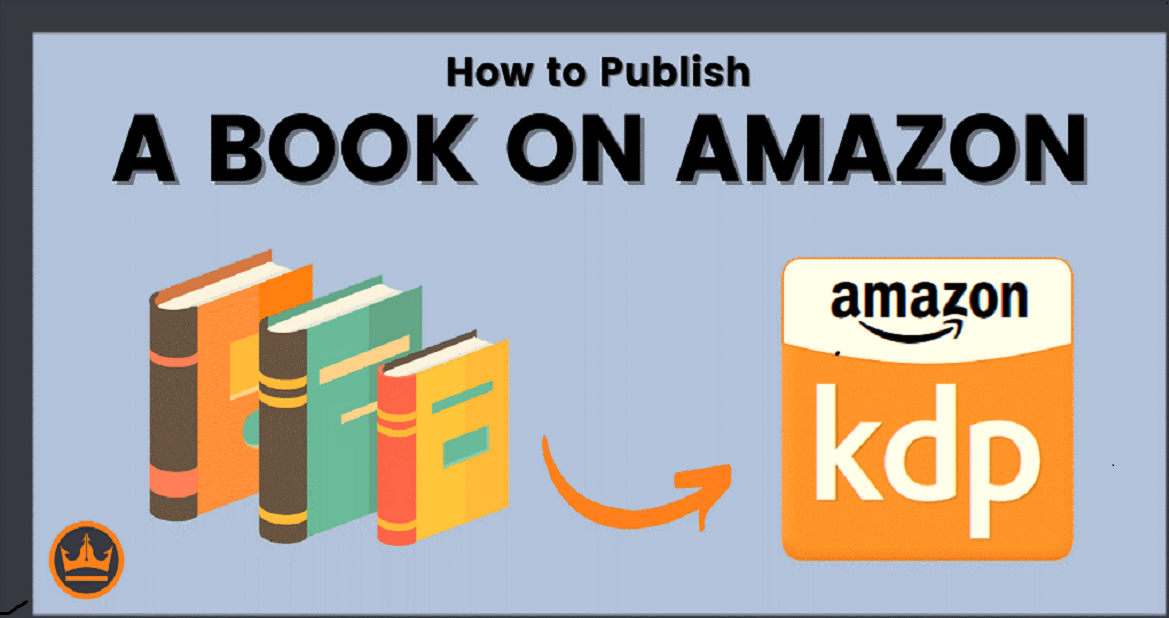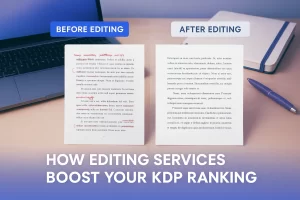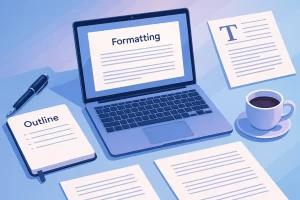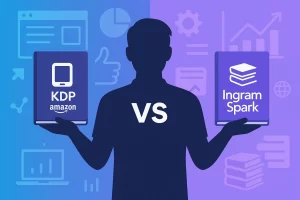Let’s suppose you are a new self-publisher entrepreneur, managing your startup publishing firm. You can invest in leveraging a self-publishing platform. If you plan to self-publish e-books, paperbacks, and hardcover books for mass production, you should seek a publishing venture that offers free publishing services. Your most preferred option is employing the Amazon Kindle Direct Publishing platform. The primary benefit of Amazon book publishing is the free publishing of e-books and paperback books, eliminating upfront inventory costs. The other key benefits, including a free-to-upload model, higher royalty rates, and a quick time to market, have empowered emerging self-publishers to shift their perspective from traditional publishing to opt for a lucrative and convenient go-to platform for publishing their books.
Amazon Kindle Direct Publishing has streamlined self-publishing, offering creative autonomy, convenience, and accessibility in publishing. The user-friendly platform allows publishers to upload, format, and publish both e-books in Kindle format and print books. Moreover, manage books’ production, marketing, and sales in the same place.
The online site offers a cost-effective method of printing, such as the Print-on-Demand (POD) service. The authors are not required to invest in large print runs; instead, POD publishes physical books and digital format books when a printing order is placed. In contrast to traditional publishing, KDP lets self-publishing authors retain their publishing control and creative rights over content development, editing, cover design, pricing, and marketing, and offer ease of publishing. They receive higher royalty rates of about 10-15% as compared to traditional publishing. Thus, the top choice KDP platform offers affordability and convenience to self-publish high-quality Kindle e-books speedily and maximize book reach and sales in the global book market.
Understanding Amazon KDP
If you are a new publisher and exploring different online publishing platforms for e-publishing, you may opt for professional publishing assistance. For instance, the leading publishing company, David McKay Publications, guides self-publishing authors with Amazon-specific expertise. They explicate the advantages of publishing on Amazon that involve retaining complete content development, design, formatting, and distribution rights. An independent writer holds copyright ownership. The authors have the autonomy of setting the list price based on readers’ changing buying trends and different sales strategies. Additionally, the author maintains their financial control and earns up to 70% royalties on e-book sales.
Amazon specialists further assist new publishers on how Amazon KDP works and convert files into print or digital formats. Self-publishers learn about opening the publisher’s account on Amazon and get free access to publishing tools. They have the flexibility to directly upload their files and export the manuscript into a print or e-book version. The e-books are distributed to a worldwide audience through Kindle Stores. While paperback and hardcover books are printed through Print on Demand Services, and are dispatched to different regions using various shipping methods.
Preparing Your Manuscript
If you lack technical expertise or resources regarding manuscript production through KDP. In such a case, look for professional publishing services that guide you through book publishing preparation. It involves rigorous editing of the manuscript. The author either prefers self-editing or hire professional editors who professionally edit and refine the quality of the content. The editors use specialized editing tools such as MS Word, Scrivener, Vellum, Grammarly, ProWritingAid, and Atticus to improve the flow and clarity in the paragraphs. The editors also analyze syntax, grammar, and typo errors. The final proofreading process involves checking the structure, layout, design, and book covers and formatting the book into print and ebook versions. Once e-books, paperbacks, and hardcover books are prepared for publishing, the publishers create a product detail page for the book comprising metadata description, keywords, pricing, and category choices to expand the book’s availability on Amazon and online platforms.
Designing an Eye-Catching Book Cover
Amazon Book Publishing facilitates self-publishers with the publishing paperback or hardcover book on KDP. The process includes creating and uploading two files. The first file covers the interior layout of the book. The front, body, and back matter. The cover file includes the exterior of the book, the front, back, and spine. Before formatting both files, the author should analyze Amazon’s cover size and resolution and formatting requirements. Regarding the formatting of the book’s trim size and margins, the publishers should adhere to the standard formatting size as maintained by KDP publishing. An appropriate trim size of the printed book in the US is 6″ x 9″ (152.4 x 228.6 mm). If the printed manuscript’s width and height are not properly measured, there is a risk of getting the manuscript rejected before printing. In case the book is printed, it will have major printing flaws.
While setting the bleed, the publisher ensures that printed objects such as background images, color, and other graphic elements and symbols reach the very edge of the finished printed page. To avoid a white border from appearing at the edge of the page after the book is trimmed, the publisher should properly place the printing designs. The next part of formatting is setting the top, bottom, and side margins to a minimum of 0.25 inches. The inside margin increases with the page count of the book. The expanded inside and gutter margin in a bound book is important, as the extra space prevents text from being hidden and keeps text clear and readable.
Book designers and formatters use dedicated software such as Canva, BookBrush, and Adobe to conduct professional book formatting. It includes image creation, designing book covers, creating a consistent visual style, improving typography, and formatting the interior layout of the book for print or digital format.
Setting Up Your KDP Account
To let independent publishers know how to self-publish on Amazon, the outstanding Amazon book publishing services provide a clear roadmap for opening and signing in to the new KDP publishing account. The process begins with signing up for a KDP account and entering the publisher’s name, email address, and secure credentials. The account registration process follows filling in the author details, including the author’s legal name, specifying the business type (individual or corporation), providing a phone number, and authenticating a bank account to receive royalty payments. The publishers are required to provide valid tax information in the tax information section. Whether the publisher is a U.S. citizen or a non-U.S. citizen and working independently or managing a publishing firm within the U.S., write a valid tax identification number, a government-issued ID, a passport, and a driver’s license in the tax interview information section. Amazon KDP requires publishers to provide an accurate taxpayer identification number to process royalty payments in compliance with international tax regulations.
Uploading Your Book to Amazon
With KDP, self-publishers have extensive publishing options. They publish e-books (Kindle) and print paperback and hardcover books. However, new publishers lack knowledge of Amazon Kindle Direct Publishing. Therefore, publishing professionals at David McKay Publication provide a comprehensive guide related to the book uploading process on KDP.
Whether the publishers intend to publish a novel, children’s books, fiction, memoirs, or comics, the experts assist them in navigating the KDP dashboard to gain knowledge of how to upload a book to Kindle Direct Publishing. The author adds book details before moving to the Manuscript & Cover section to upload the formatted book. The essential details inserted include the title, subtitle, series information, and edition. The Amazon page details allow publishers to mention the list of contributors comprising the author, editor, or illustrator. Moreover, they add a compelling metadata description that explicates the main plot, theme, and settings of the book. Insert relevant keywords that are commonly used by the audience to search the publication. Adding Amazon categories to the Amazon book page allows publishers to identify the categories of books required to increase potential sales. The publishers provide information about the book’s ISBN. For each format, e-book, paperback, and hardcover, the publisher purchases a unique ISBN code.
Before uploading the manuscript, the publishing team previews the book content and edits the Amazon page details. Once the book is published, they match book details to ensure the published manuscript’s availability in the Amazon catalog.
Pricing Your Book for Success
To keep updated with the cost of publishing a book in 2025, the authors are required to know the varying pricing and royalty rates of different publishing routes. The royalty rates of traditional publishing vs self-publishing differ. Traditional publishers create their royalty rates for printed books, around 10% to 15% of the sale price. These royalty rates are too less as compared to KDP’s self-publishing royalty rates.
The Amazon publishing experts create an effective Amazon KDP pricing strategy for print and e-books. It includes Amazon’s royalty structure of 35% and 70%, based on specific pricing criteria. Opting for a 70% royalty for ebooks involves a price range between $2.99 and $9.99. The author needs to meet criteria related to distribution rights and page-count requirements, as Amazon takes a delivery fee for each book downloaded. With a 35% royalty option, the author pays a relatively lower price and no delivery fee deduction from Amazon. Therefore, it becomes profitable for self-published authors to publish a hefty volume.
The paperback royalty includes 50% to 60% royalty rate based on the marketplace price list. The printing cost is deducted depending on trim size, page count, ink, and paper type.
The pricing strategy of Amazon KDP helps in increasing book visibility and elevating sales volume. Amazon and Kindle countdown deals and promotions, a significant pricing strategy, entice a vast audience to avail a free 90-day program. It comprises Kindle Unlimited (KU), a subscription program that allows customers to conveniently read Kindle e-books and keep them for a monthly subscription fee. When an author is enrolled in KDP Select, their Kindle e-books are automatically enlisted in Kindle Unlimited (KU). Consequently, the e-book is available for sale, and it helps authors earn higher royalty rates from the book sales.
Marketing Your Book on Amazon
Publishers Remain Compliant with Amazon Trademark Usage Guidelines
To improve your book’s Amazon marketing and sales rank implies book writing services to comply with Amazon’s Trademark. The publishers are forbidden from using Amazon’s name, logo, and other Amazon trademarks to avoid disparagement. Consequently, the publishers are required to properly display Amazon trademarks in Amazon ads and on associated websites in accordance with the up-to-date version of the trademark guidelines.
Amazon Author Central
To execute marketing strategies on Amazon, the marketing and sales team at David McKay Publications facilitates authors in creating an Amazon Author Central. It comprises an Amazon Author Page and the book’s detail page, where the publishers share their updated profiles in different languages, add photos, and provide book details. Amazon Author Central also showcases constructive customer reviews and editorial analysis for the published books on the Amazon KDP. Moreover, the authors also add an ISBN and a recent edition of the book to increase book discoverability on Amazon.
Optimizing your book description To Boost Book Visibility
To let consumers search for the preferred book on Amazon, the publishers use striking and relevant keywords related to the book’s content and theme. The keyword strategy makes manuscript search easier on Amazon and Google. Compelling metadata descriptions, titles, and book genres help the audience learn about book features. Captivating headings in bold and italics, and other publishing items, increase a book’s ranking on Amazon and boost a published book’s discoverability on the Google search engine.
Importance of Amazon A+ Content for Better Engagement
McKay Publications further assists self-publishing authors in marketing their published books on online platforms. Publishers create A+ Content from the KDP Marketing page. They move to the A+ Content Manager and upload the content. They add images, text, and comparison tables to create a visually pleasing Amazon detail page. As A+ content is developed, the published manuscript is easily discoverable on KDP marketplaces. More readers get attracted to the book’s detail page and consider buying the book.
How to get Customer Reviews on Amazon’s Book Detail Page
Amazon’s publishing team at professional book publishing services adds productive customer responses and recommendations on the Amazon review site. The consumers who have purchased the book provide their reviews regarding the significance of reading the book, the manuscript’s publishing quality, and appropriate pricing. Positive customer reviews found on the review section further guide other buyers in making informed purchase decisions. Trustworthy customers also help in promoting the published manuscript among other clients and stakeholders.
To submit the review, consumers click on the reviews section of the book page and write a book review. After writing the review, the customer leaves a star rating and optionally adds a striking text, image, or video about the print book or e-book on the product detail page. The Amazon Community team manages customer reviews and posts reviews once. After the submission, they check the quality of customer feedback, ensuring that the reviews meet the Community Guidelines.
Leveraging Amazon Ads
To run an ad campaign on Amazon, the publishing team creates sponsored products ads that make the books visible on the Amazon store. Amazon-sponsored book ads appear on product detail pages that promote a single book on shopping results. Sponsored brands demonstrate different categories of books published on Amazon. Amazon marketers run targeted ad campaigns that target customers based on keywords they use for book searching. The attention-grabbing video ads introduce the author and his published works to new readers. The ads direct shoppers to a detail page for online manuscript purchasing.
Post-Publishing Strategies
Tracking Sales and Royalties on the KDP Dashboard
To monitor their sales and royalties on the Kindle Direct Publishing (KDP) dashboard, Professional book publishing services sign in to their Amazon KDP account and click on the reports tab located at the top of the page. They navigate the dashboard and review their detailed reports related to sales, royalties, and Kindle Edition Normalized Pages (KENP) read. The other reports comprise the orders report that demonstrates the finalized book orders for e-books and print books. The orders are confirmed after receiving the customer’s payment. The royalties estimator shows the anticipated earnings to be received from annual book sales and the book marketplace.
How to Adjust Pricing, Keywords, and Categories after Book Launch
To promote post-book launch, the publishers should update the book details on their Amazon Kindle publishing account. Clicking on KDP Bookshelf, the authors choose to edit details and update author information. The updated book details include metadata description, keywords, book categories, regions, and prices. For print books, the author should provide an ISBN identifier code that helps bookstores, libraries, and book distributors to discover the required book in a digital catalog. ISBNs for e-books suggest that authors and publishers link their names with the identification code. Many Amazon publishers use the ASIN, the identifier number provided to the publisher for published e-books.
Importance of Continuous Promotion on Social Media, Blogging, and Email Marketing
The marketing experts conduct a post-book publishing campaign on Amazon by creating a product page. The authors compose engaging Amazon book posts that promote the manuscript and introduce the publication and the author to new and existing readers. The writers add informative guest posts or blogs that exhibit book features, and include a link to the Amazon page and social media hashtags of an author’s book page. Amazon posts encourage readers to visit the social media pages to make more pre-orders and avail exclusive Amazon and Kindle promotions. Amazon’s email marketing campaign includes launch announcements. The marketers send emails to the extensive email list, providing book launch updates and keeping the audience updated with new releases and upcoming post-launch book activities. Moreover, the email marketers incentivize customers by offering special deals and promotions that bring high sales.
Expanding Audiobook Distribution with ACX (Audible)
If you plan to increase ACX audiobook distribution, register your book in the Audible Global Reach program using your ACX account. By signing up for your ACX account, your audiobook gets more visibility on numerous Audible retail channels. To distribute and sell your books on other platforms implies that publishers choose a non-exclusive distribution option to deliver the audiobooks to other retailers. Thus, enrolling in Audible Global Reach expands audiobook reach to different territories and regions.
Building a Long-Term Author Brand
In a competitive publishing landscape, authors are required to build a strong author brand to enhance their online presence. Establishing their credibility on Amazon suggests authors create an Amazon Author Central. It includes a detailed author page that allows authors to add their updated profile, photo, and list of published books. An attractive author page keeps readers informed about the author’s new releases in audible and kindle book formats. The authors also promote their published books by creating an author’s website. Consumers browse the product page and make direct online purchases. The authors organize live book reading sessions, Q&A, and podcasts that connect authors with potential readers. Moreover, loyal customers get involved with cross-promotion. They explore the author’s other publications and extensively promote the author’s works. Hence, it leads to increased sales and brings high revenue.
To Recapitulate
First-time authors choose Amazon’s Kindle Direct Publishing (KDP) for its convenient and user-friendly interface, which leads to cost cost-effective and quick publishing process. Novice authors prefer KDP Amazon publishing over traditional publishing as it provides creative control and autonomy in managing content development, design, formatting, marketing, pricing, and sets royalty rates based on higher sales volume. Self-publishing authors who lack prior knowledge of self-publishing on KDP have the option to seek professional assistance from publishing services. The publishing expert guides authors regarding opening a publishing account on Amazon. As they sign in to the account, the authors are required to provide their updated author details, business specifics, and publication details.
In the next step, the Amazon publishing team facilitates in uploading of the file. The authors navigate the dashboard to create two files. They edit and improve the book formatting and structure, and modify content quality. As the book is edited and proofread, the formatters convert the file into a print and e-book version. Before uploading and publishing, the Amazon marketer adds metadata description, keywords, ISBN, and other details that help in fast book discoverability on Amazon. Furthermore, KPD offers print-on-demand service that helps new publishers to eliminate publishing costs. The cost-effective publishing mode print single or bulk printed books as per the client’s order. The printed manuscripts are available on global Amazon stores within 72 hours. New authors and publishers are encouraged to opt for the online publishing route as it provides them a direct access to the Amazon publishing platform. The publishers build their customer base worldwide and increase their publication visibility and sales potential across the globe. Another significant aspect is that Amazon Publishing allows authors to obtain attractive royalty rates up to 70% on e-book sales. Moreover, they get enrolled in KDP Select and get additional benefits such as Kindle Unlimited subscription program, free book promotions, and Kindle Countdown Deals.




